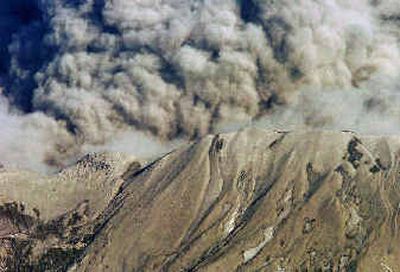Volcano’s allure lasts a lifetime

MOUNT ST. HELENS, Wash. – Forest Service ranger Scott Hinderman is flustered. He’s trying to tell a group of tourists about the 1980 eruption of Mount St. Helens. But they’re more interested in the sight of television personality Geraldo Rivera strutting by.
Hinderman regains their attention by pulling out one of his standard crowd pleasers. It’s a photograph of himself as a 5-year-old boy, leaning in swim trunks against a dock on a lake as the volcano blows its top.
The tactic works – at least until Geraldo walks by again.
The recent reawakening of Mount St. Helens has drawn thousands of people to the volcano. Even if they are occasionally distracted by the media, many have an insatiable interest in information about the landscape, its history and how scientists predict eruptions.
That attention has been satisfying for many rangers, but perhaps most of all for a handful of rangers who, like Hinderman, grew up nearby.
“St. Helens is such a dynamic, changing area,” said Hinderman, a 29-year-old native of Tacoma.
“Year after year, season after season, these changes occur. And when people are interested in what they’re seeing, when they’re enthusiastic – by no stretch of the imagination are we rock stars, but we are the center of attention up here.”
Forest Service ranger Pamela McCray and her boyfriend of three years, ranger Jason Harrison, experienced different ends of the 1980 blast, which killed 57 people and devastated 230 square miles of forest.
She was 6, and her dad drove her from their home in Clatskanie, Ore., across the Columbia River to Kalama, Wash., to watch the eruption. More than 200 miles away, ash from the plume darkened the sky over Spokane, and Harrison, then 7, had to wear a breathing mask on his way to school.
“I went to school for art, but when I got done, I decided I really wanted to just be out in the woods,” McCray said.
She started working for the Northwest Interpretive Association, a nonprofit bookstore that funds the Coldwater Ridge Visitors Center, and Johnston Ridge Observatory. She fell in love with Harrison and the landscape.
“I feel totally blessed. I mean, look at what a geek I am – I’m here on my day off,” she said.
Ranger Jerry Gould was only 3 months old in 1980 when the volcano erupted. But she grew up in Castle Rock, one of the closest towns to the blast zone. She remembers smirking when she would see tourists buying volcanic ash at souvenir shops when they could just walk down to the Toutle River and get it themselves.
Sometimes, she concedes, she got bored with all the adult talk about the volcano. That all changed five years ago after high school, when she, too, began working at the bookstore.
“You just fall in love with this place. It’s so fascinating and changing all the time,” she said.
And since Sept. 23, when scientists first detected a flurry of earthquakes in the crater, “I’ve just had a permanent grin on my face,” she said.